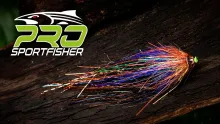John Shewey has something going on with steelhead with several books on the subject already under his belt.
Updated or edited 6 months ago
John Shewey has something going on with steelhead with several books on the subject already under his belt. Add to that some really excellent pattern and fly tying books like the new-classic Spey Flies & Dee Flies, and you get a picture of a man who loves steelhead and flies.
That love shines through in this volume from earlier this year. A whole book dedicated to the US steelhead flies that were developed from the 20's and up into the 60's. These flies formed a school when they emerged, and since most of them were easy to tie, used few and simple materials and were durable producers too, they reigned US steelhead fishing for decades, and can still be found in many flyboxes.
But during the latest decade or more, a new breed of flies have entered and almost taken over the steelhead scene - at least when we're not talking surface flies. The large, colorful, gaudy and oftentimes complex flies like the omnipresent Intruders, the Popsickles and many other large, often articulated, tube or shank based flies.
As much as I love the new flies and as much as they undoubtedly catch steelhead, I still have a weak spot for the Parmecene Belles, The Skykomish Sunrises and not least the Spey fly inspired flies from the hands of people like Syd Glasso.
Many of these flies get a prominent place in this book, where a hundred or so flies are covered in details with a well researched and thorough text on the history and background of each, illustrated with a large and beautiful photo as well as a materials list.
Each page spread is a joy mainly due to the great photographs by the author. Some flies get two pages and a full page photo while others get a little less space.
Unfortunately the materials lists have been gathered in an appendix in the back of the book, and you have to leaf back and forth to see what's needed to tie the flies. I wish these lists had simply been added below the text under each fly. There's enough space on most of the pages, and it would have saved a lot of referencing back and forth.
The book also has a section on fly tying, and while it might seem appropriate to mention some of the techniques used, I honestly don't think the flies are complex enough or the potential reader green enough to raise the need for tying tips. There's a few flies tied from start to end in the book, and they are chosen in such a way that they illustrate most of the steps needed.
It's a pet peeve of mine that I have mentioned many times before: People buying specialty books like this are not likely to be strangers to hackling techniques or burling tinsel or floss.
But none the less this is an excellent book, which covers a subject that will be interesting to thousands of steelhead angler and tyers as well as those of us interested in the history of fly patterns.
- Log in to post comments







